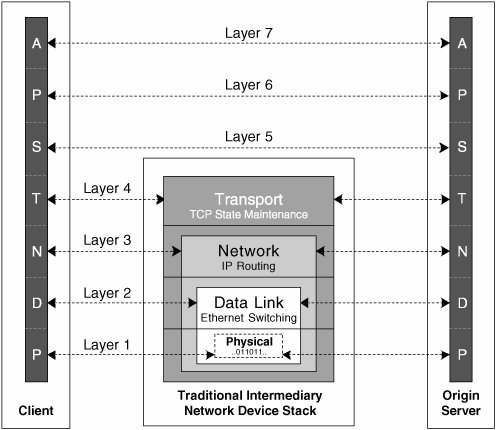Understanding the Underlying Technologies
| The need for the network to add value to applications is advanced by a growing thirst for more robust applications, which are able to respond instantaneously. Traditional networking software operated at intelligence levels too low to accelerate services, which were governed by these aggressive demands. However, a network installed with Cisco content networking software can be seamlessly enabled for content-awareness and thus easily fulfill such demands. This book focuses on the content-aware Layers 4 through 7 of the OSI model. The OSI model is a standard reference for understanding networks and developing other standards. OSI is used most commonly as a detailed reference for which vendors develop networking protocol stacks, which in turn can themselves become standards. Consider each layer of the OSI model to be a process responsible for a set of actions to be performed on an item of information on behalf of upper layers. When the item is processed at one layer, it is passed directly to the next layer for processing. Each layer also communicates indirectly with adjacent layers on other devices and specifies the addressing and identification details used among them. Whereas devices connect physically to each neighbor at Layer 1, all layers above Layer 1 connect logically to the same layer on the communicating device. For Layers 2 and 3, the communicating devices are often switches and routers, respectively. For example, a workstation can connect logically at Layer 2 to another workstation through a Layer 2 switch. For Layer 4, the communicating device is often a firewall, or any network device capable of maintaining transport state information. In traditional networks, for Layers 5 through 7, the applications running on the client and origin server are in logical communication with one another over the network. Figure 1-2 illustrates the OSI model in traditional networks. The dotted lines represent inter-process communication between adjacent layers. Figure 1-2. The OSI Reference Model in Traditional Networks Before content networking, intermediary devices in the network would stop processing information at Layers 2, 3, and 4 in switches, routers, and firewalls, respectively. Within content networking devices, however, the processing continues up the protocol stack in order to add intelligence to the information exchanged between the communicating applications, as illustrated in Figure 1-3. Bear in mind that, although content networking devices are specialized for Layers 5 through 7 processing, they have numerous capabilities to process information at Layers 1 through 4. Figure 1-3. The OSI Reference Model in Content Networks TCP/IP is the predominant network protocol suite of the Internet today. It is based on the OSI reference model, but its details are specific to the requirements of today's networks. This book focuses on characteristics of the OSI model as they pertain to TCP/IP. Chapter 2, "Exploring the Network Layers," will explain the lower four layers of the OSI model with respect to TCP/IP-based routing and switching and their related protocols. Although these lower layers are essential to understanding almost all content networking technologies, this book focuses more on subjects related to the upper-three OSI layers. These layers are rarely referenced separately in this book and are therefore combined and referred to collectively as "Layers 5 through 7," or simply "Layers 57." Tip For an example trace of an actual application message passing through each layer of the TCP/IP protocol stack, see the "Putting It All Together with a Detailed Network Trace" section in Chapter 2. |
EAN: 2147483647
Pages: 178
